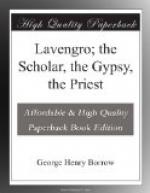There was something very peculiar in the sound of that bueno—I never forgot it.
Thereupon a conversation ensued between Rabbi Manasseh and the Armenian, in a language which I knew to be Spanish, though a peculiar dialect. It related to a mercantile transaction. The Rabbi sighed heavily as he delivered to the other a considerable sum of money.
‘It is right,’ said the Armenian, handing a receipt. ’It is right; and I am quite satisfied.’
’You are satisfied—you have taken money. Bueno, I have nothing to say against your being satisfied.’
‘Come, Rabbi,’ said the Armenian, ’do not despond; it may be your turn next to take money; in the meantime, can’t you be persuaded to taste my Cyprus?’
’He—he—he! senor, you know I do not love wine. I love Noah when he is himself; but, as Janus, I love him not. But you are merry; bueno, you have a right to be so.’
‘Excuse me,’ said I; ‘but does Noah ever appear as Janus?’
‘He—he—he!’ said the Rabbi, ’he only appeared as Janus once—una vez quando estuvo borracho; which means—’
‘I understand,’ said I; ‘when he was . . .’ and I drew the side of my right hand sharply across my left wrist.
‘Are you one of our people?’ said the Rabbi.
‘No,’ said I, ’I am one of the Goyim; but I am only half enlightened. Why should Noah be Janus when he was in that state?’
‘He—he—he! you must know that in Lasan akhades wine is janin.’
‘In Armenian, kini,’ said I; ’in Welsh, gwin; Latin, vinum; but do you think that Janus and janin are one?’
’Do I think? Don’t the commentators say so? Does not Master Leo Abarbenel say so in his Dialogues of Divine Love’?
‘But,’ said I, ’I always thought that Janus was a god of the ancient Romans, who stood in a temple open in time of war, and shut in time of peace; he was represented with two faces, which—which—’
‘He—he—he!’ said the Rabbi, rising from his seat; ’he had two faces, had he? And what did those two faces typify? You do not know; no, nor did the Romans who carved him with two faces know why they did so; for they were only half enlightened, like you and the rest of the Goyim. Yet they were right in carving him with two faces looking from each other—they were right, though they knew not why; there was a tradition among them that the Janinoso had two faces, but they knew not that one was for the world which was gone and the other for the world before him—for the drowned world and for the present, as Master Leo Abarbenel says in his Dialogues of Divine Love. He—he—he!’ continued the Rabbi, who had by this time advanced to the door, and, turning round, waved the two forefingers of his right hand in our faces; ’the Goyims and Epicouraiyim are clever men, they know how to make money better than we of Israel. My good friend there is a clever man, I bring him money, he never brought me any; bueno, I do not blame him, he knows much, very much; but one thing there is my friend does not know, nor any of the Epicureans, he does not know the sacred thing—he has never received the gift of interpretation which God alone gives to the seed—he has his gift, I have mine—he is satisfied, I don’t blame him, bueno.’




